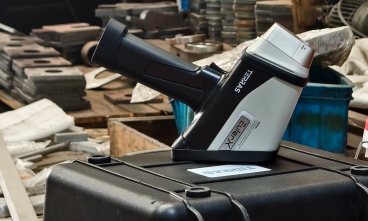
Alloy
A high-tech enterprise focusing on the development and application of X-ray technology products, committed to becoming a leading supplier of X-ray industrial testing solutions.
XRF Testing: The Non-Destructive Way to Analyze Materials
In today’s world, material analysis is critical in various industries, from manufacturing and construction to environmental science and archaeology. One of the most efficient and non-destructive ways to analyze materials is through X-Ray Fluorescence (XRF) testing. This method allows for the precise identification and quantification of elements in a material without altering the sample. Let’s explore how XRF works, its applications, and the benefits it offers.
What is XRF Testing?
XRF testing is a non-destructive technique used to determine the elemental composition of a material. It works by exposing the sample to high-energy X-rays, causing the elements in the material to fluoresce (emit secondary X-rays) at characteristic wavelengths. These emitted X-rays are then detected by an XRF analyzer, which provides a spectrum that can be interpreted to identify the elements present and their concentrations.
The process is quick, efficient, and requires no sample preparation, making it ideal for a variety of industries and research purposes.

How Does XRF Work?
When a sample is irradiated with X-rays, the energy from the X-rays knocks electrons out of the inner shells of atoms within the material. This creates vacancies in the atoms, which are filled by electrons from higher energy levels. As electrons fall back to lower energy levels, they release energy in the form of fluorescent X-rays. These X-rays have specific wavelengths that correspond to particular elements, making it possible to identify the elements present in the material.
XRF analyzers measure the energy and intensity of the fluorescent X-rays, and using this data, they generate a detailed elemental composition report.
Applications of XRF Testing
XRF testing is used in a wide array of fields, offering a versatile solution for both industrial and research applications:
Environmental Science: XRF is often used to analyze soil, water, and air samples to detect contaminants such as heavy metals. This non-destructive technique is essential in environmental monitoring and cleanup projects.
Material Science: In metallurgy, XRF is used to analyze the composition of metals and alloys. This helps ensure quality control in manufacturing processes and product development.
Archaeology and Art Conservation: XRF is employed in the analysis of artifacts and artworks, providing insights into the materials used in ancient structures, pottery, and paintings without causing any damage.
Quality Control in Manufacturing: Many industries, including electronics, automotive, and construction, use XRF testing to ensure that their materials meet regulatory standards and quality specifications. For example, it can detect lead content in electronics or construction materials to comply with safety regulations.
Mining and Geology: XRF is a critical tool in the mining industry for the rapid and accurate analysis of ores and minerals, helping to determine their economic viability.
Benefits of XRF Testing
Non-Destructive: The biggest advantage of XRF testing is that it doesn’t alter or damage the sample being analyzed. This is crucial when dealing with valuable or irreplaceable materials, like ancient artifacts or rare minerals.
Fast Results: XRF provides immediate results, often in just a few minutes. This allows for real-time analysis, enabling quick decision-making and reducing delays in production processes.
Portable and Easy to Use: Portable XRF analyzers can be used on-site, allowing for on-the-spot testing without the need to send samples to a laboratory. This mobility is especially beneficial in fields like environmental monitoring and mining.
Wide Range of Elements: XRF can detect a broad spectrum of elements, from light elements like magnesium to heavy metals like uranium. This makes it versatile for a wide variety of applications.
Minimal Sample Preparation: In most cases, XRF testing requires little to no sample preparation, which saves time and costs associated with preparing samples for other types of analysis.
Limitations of XRF Testing
While XRF is an incredibly valuable tool, it does have some limitations:
Detection Limits: XRF is most effective at detecting elements in concentrations ranging from parts per million (ppm) to percentage levels. For very low concentrations of certain elements, more sensitive techniques like ICP-MS may be needed.
Surface Sensitivity: XRF analyzes the surface of the material, so it may not provide accurate results for materials that have heterogeneous composition at different depths.
Matrix Effects: The presence of certain elements in the material can interfere with the accuracy of the results, especially when analyzing complex samples with overlapping elemental signals.

Terras EulerX900 Handheld Alloy Analyzer
Ideal for industrial and environmental applications, the EulerX900S XRF spectrometer delivers rapid, non-destructive elemental analysis with outstanding precision. By detecting characteristic X-ray emissions, it identifies metal compositions, alloy grades, and contaminants—essential for quality assurance, scrap metal recycling, and pollution monitoring. The portable variant is built for tough conditions, featuring an intuitive touchscreen and Wi-Fi for real-time data sharing. With a detection range of Mg to U and flexible calibration options, it ensures reliable on-site measurements.
Conclusion
XRF testing is a powerful, non-destructive method for analyzing materials in a wide range of industries. Its ability to quickly and accurately identify the elemental composition of a sample makes it invaluable in research, quality control, environmental monitoring, and more. Despite its limitations, the convenience, speed, and non-destructive nature of XRF testing make it an essential tool for professionals working with materials across various fields. Whether you are in manufacturing, archaeology, or environmental science, XRF can provide you with the data you need to make informed decisions.
Join Us
Subscribe to our email list for updates & promotions.



